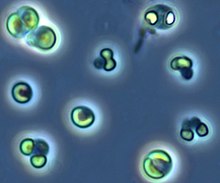| Picocystis | |
|---|---|
 | |
| Picocystis salinarum | |
| Scientific classification | |
| Clade: | Viridiplantae |
| Division: | Chlorophyta |
| Class: | Picocystophyceae Eikrem & Lopes dos Santos |
| Order: | Picocystales Eikrem & Lopes dos Santos |
| Family: | Picocystaceae Eikrem & Lopes dos Santos |
| Genus: | Picocystis R.A.Lewin 2001 emend. Eikrem & Lopes dos Santos 2017 |
| Species: | P. salinarum |
| Binomial name | |
| Picocystis salinarum R.A.Lewin 2001 | |
Picocystis is a monotypic genus of green algae, the sole species is Picocystis salinarum. [1] It is placed within its own class, Picocystophyceae in the division Chlorophyta. [2]